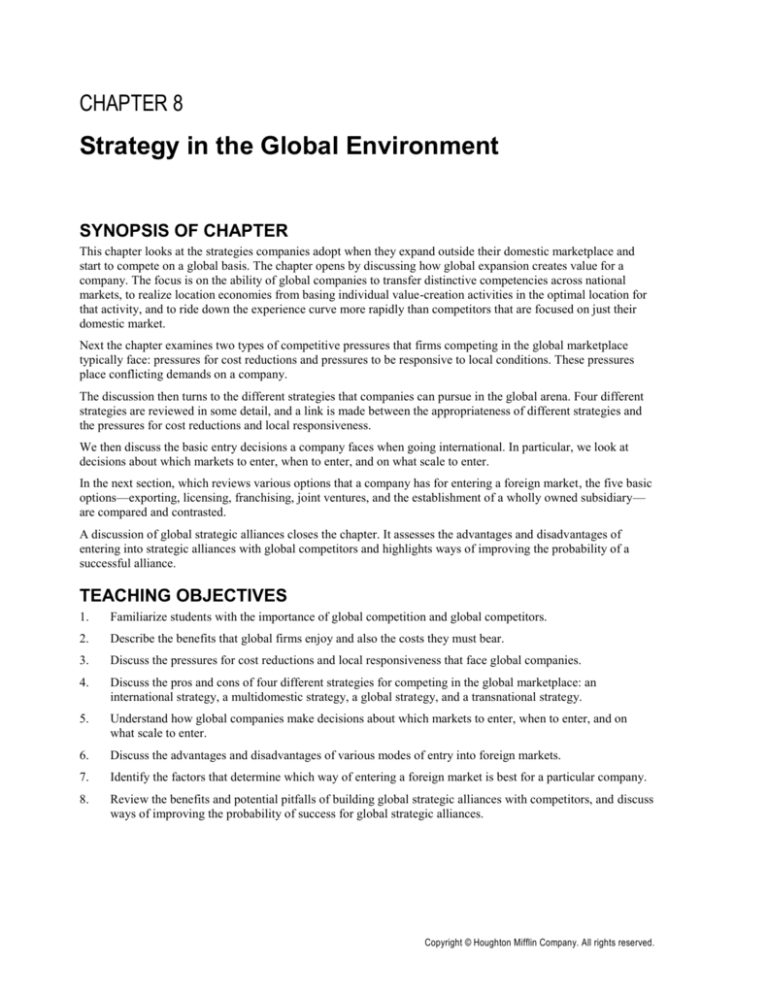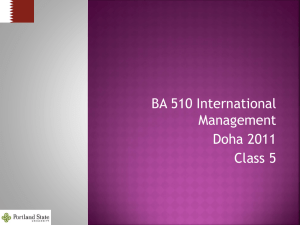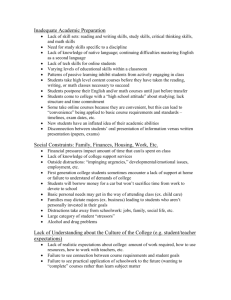
CHAPTER 8
Strategy in the Global Environment
SYNOPSIS OF CHAPTER
This chapter looks at the strategies companies adopt when they expand outside their domestic marketplace and
start to compete on a global basis. The chapter opens by discussing how global expansion creates value for a
company. The focus is on the ability of global companies to transfer distinctive competencies across national
markets, to realize location economies from basing individual value-creation activities in the optimal location for
that activity, and to ride down the experience curve more rapidly than competitors that are focused on just their
domestic market.
Next the chapter examines two types of competitive pressures that firms competing in the global marketplace
typically face: pressures for cost reductions and pressures to be responsive to local conditions. These pressures
place conflicting demands on a company.
The discussion then turns to the different strategies that companies can pursue in the global arena. Four different
strategies are reviewed in some detail, and a link is made between the appropriateness of different strategies and
the pressures for cost reductions and local responsiveness.
We then discuss the basic entry decisions a company faces when going international. In particular, we look at
decisions about which markets to enter, when to enter, and on what scale to enter.
In the next section, which reviews various options that a company has for entering a foreign market, the five basic
options—exporting, licensing, franchising, joint ventures, and the establishment of a wholly owned subsidiary—
are compared and contrasted.
A discussion of global strategic alliances closes the chapter. It assesses the advantages and disadvantages of
entering into strategic alliances with global competitors and highlights ways of improving the probability of a
successful alliance.
TEACHING OBJECTIVES
1.
Familiarize students with the importance of global competition and global competitors.
2.
Describe the benefits that global firms enjoy and also the costs they must bear.
3.
Discuss the pressures for cost reductions and local responsiveness that face global companies.
4.
Discuss the pros and cons of four different strategies for competing in the global marketplace: an
international strategy, a multidomestic strategy, a global strategy, and a transnational strategy.
5.
Understand how global companies make decisions about which markets to enter, when to enter, and on
what scale to enter.
6.
Discuss the advantages and disadvantages of various modes of entry into foreign markets.
7.
Identify the factors that determine which way of entering a foreign market is best for a particular company.
8.
Review the benefits and potential pitfalls of building global strategic alliances with competitors, and discuss
ways of improving the probability of success for global strategic alliances.
Copyright © Houghton Mifflin Company. All rights reserved.
Chapter 8: Strategy in the Global Environment
95
OPENING CASE: MTV HAS TO SING A NEW SONG AS IT EXPANDS
GLOBALLY
MTV Networks is one of the most successful businesses at globalization, with 29 distinct channels reaching 330
million subscribers, generating a profit of over $1 billion annually. In 1987, its first year of overseas operations,
MTV managers naively assumed that Europeans would be interested in American pop stars and commentary.
Soon, copycats began to offer local programming, spurring MTV to create separate, regional channels, including
eight in Europe and six in Asia. Forty percent of the programming and 70 percent of the music videos feature
local performers, and all of it is delivered by local VJs (video jockeys). Ratings are growing and the threat from
copycats is much less. Even more importantly, advertising revenues are up, especially revenues from local
advertisers.
Teaching Note: This case illustrates the way in which a firm that experienced success in its home country began
the process of globalization. MTV’s experience with globalization was hesitant and error-prone at first, but they
learned from those experiences. To discuss this case in class, ask students to consider the benefits that MTV has
received from its globalization efforts. Then ask them to describe MTV’s current global strategy, and point out
any potential weaknesses that must be addressed.
LECTURE OUTLINE
I.
II.
Overview
A. This chapter considers the contribution of global strategy to the process of building and maintaining a
competitive advantage, outlining and discussing global strategies.
B.
Also covered are the decisions managers make about when and how to enter a foreign market.
C.
Multinational companies, companies that do business in two or more countries, are also discussed,
as are global strategic alliances.
Increasing Profitability Through Global Expansion
A. Expanding globally lets both large and small companies increase their profitability in a number of
ways not available to purely domestic enterprises.
B.
One way for firms to increase their profitability through internationalization is the realization of
location economies, those benefits that arise from performing a value-creation activity in the optimal
location for that activity, wherever in the world that might be.
1.
One benefit of location economies is the lowering of costs for raw materials, power, labor, and
so on. This is consistent with the business-level strategy of cost leadership.
2.
Another benefit of location economies is the firm’s improved ability to differentiate its product,
consistent with a differentiation business-level strategy.
3.
However, a negative consequence of pursing location economies is the potential for increased
transportation costs and unfavorable trade barriers.
4.
Another possible negative consequence is the increased political and economic risk in regions
where governments are unstable or implementing unfavorable business policies.
C.
Another way that firms can benefit from global expansion is through the increased ability to ride
down the experience curve, reducing the costs of production over the life of a product. Moving down
the experience curve is consistent with the business-level strategy of cost leadership.
1.
Global markets are larger than domestic markets, and therefore companies that serve a global
market from a single location are likely to build up accumulated volume quickly.
2.
The cost advantages of serving the world market from a single location will be all the more
significant if that location is also the optimal one for realizing location economies.
D. Yet another benefit of global expansion is the ability to further exploit distinctive competencies.
Companies with valuable distinctive competencies can often realize enormous returns by applying
those competencies to foreign markets, where indigenous competitors lack similar competencies.
STRATEGY IN ACTION 8.1: MCDONALD’S IS HERE, THERE, AND
EVERYWHERE
As the U.S. fast food market became saturated, McDonald’s began to open global franchises. Today, 90 percent of
their new restaurant openings are overseas. And the firm is planning further expansion to increase penetration,
especially in developing countries. However, McDonald’s has had to adjust its business model. In the U.S. tight
Copyright © Houghton Mifflin Company. All rights reserved.
96
Chapter 8: Strategy in the Global Environment
relationships with suppliers and standardization help to drive down costs. Overseas stores prepare American
staples, but they also have the flexibility to offer foods suited for local tastes.
McDonald’s biggest problem has been to replicate its U.S. supply chain in foreign countries. The firm maintains
rigorous specifications for all raw materials, but local suppliers are less willing to make the investments required
to meet them. McDonald’s approach in Russia was to vertically integrate through the entire supply chain,
managing dairy and vegetable farms and building a $40 million food-processing plant. Increasingly, the firm is
finding that its foreign franchisees are a source of valuable new ideas.
Teaching Note: McDonald’s is using the distinctive competencies they developed in their home country, such as
cost cutting and input standardization, to gain advantage in foreign markets, where competing restaurants do not
have those skills. Their business model is so successful and so strongly ingrained in the company’s operations that
when a piece of the puzzle is missing, as it was in Russia, then McDonald’s takes on the heroic task of providing
that piece themselves, rather than change the model. To generate discussion, have students think critically about
McDonald’s attachment to its business model. Does it always make sense, for example, as in Russia? What are the
benefits of their approach? What are the negative consequences?
E.
Another benefit of global expansion is the ability of multinational firms to leverage the skills of
global subsidiaries. Multinational firms with foreign subsidiaries can have valuable competencies
arise in any of their locations, and then share that knowledge with other subsidiaries. This creates
important new challenges for managers.
1.
Managers must recognize that competencies can develop anywhere, and be on the lookout for
those new competencies.
2.
The firm must have an incentive system for local subsidiaries to develop new competencies.
3.
Managers must be able to identify new competencies and help to transfer them within the
company.
STRATEGY IN ACTION 8.2: HEWLETT PACKARD IN SINGAPORE
Hewlett Packard needed a low-cost overseas location for manufacturing facilities, and Singapore was ideal, with
low labor costs, an educated, English-speaking workforce, a stable government, and good national infrastructure.
Singapore officials also negotiated a favorable tariff agreement with HP. The factory began manufacturing basic
components, but as they demonstrated their capability, HP managers began to trust them with more sophisticated
manufacturing tasks. Then, in the early 1980s, HP gave the Singapore workers responsibility for a complete
redesign of a handheld calculator. Singapore took over the redesign of ink jets and keyboards, typically reducing
manufacturing expenses by 30 percent. Today, the Singapore facility is responsible not just for manufacturing, but
also for the redesign of many HP products for Asian markets.
Teaching Note: This case shows how HP benefited far more than it expected in its relationship with its Singapore
managers. The relationship was so successful as a result of actions taken on both sides. The workers at the
Singapore facility were talented, motivated, and persevering in their tasks. HP officials saw the talent at
Singapore, gave the workers the resources and training to expand their abilities, and rewarded them for high
performance by giving them more autonomy. Students may be inclined to think of the relationship between a
large U.S. company and its overseas facilities as exploitative, an opinion based perhaps on media coverage of
problems uncovered at Nike and other manufacturers. You can use this case to show by counterexample that the
relationship can be mutually beneficial and still be cost-effective for the U.S. firm.
III.
Pressures for Cost Reductions and Local Responsiveness
A. Companies that compete in the global marketplace face competitive pressures for cost reductions and
pressures to be locally responsive. These competitive pressures place conflicting demands on a
company.
1.
Responding to pressures for cost reductions demands that a company try to minimize its unit
costs. To accomplish this, a company must base its activities at the most favorable low-cost
location, wherever in the world that might be. It must also offer a standardized product to the
global marketplace in order to ride down the experience curve as quickly as possible.
2.
Reacting to pressures to be locally responsive requires a company to differentiate its product
offering and marketing strategy from country to country. It must try to accommodate the
Copyright © Houghton Mifflin Company. All rights reserved.
Chapter 8: Strategy in the Global Environment
97
diverse demands arising from national differences, which can lead to significant duplication and
a lack of standardization, raising costs.
Show Transparency 54
Figure 8.1: Pressures for Cost Reductions and Local Responsiveness
B.
IV.
Pressures for cost reductions arise from several sources.
1.
Pressures for cost reductions are intense in industries producing commodity-type products that
serve universal needs. For these products, differentiation on nonprice factors is difficult and
price is the main competitive weapon.
2.
Pressures for cost reductions are also strong in industries where major competitors are based in
low-cost locations, where there is persistent excess capacity, and where consumers are powerful
and face low switching costs.
3.
Liberalization of the world trade and investment environment in recent decades has generally
increased cost pressures by facilitating greater international competition.
C.
Pressures for local responsiveness arise from several sources.
1.
One source of strong pressures for local responsiveness emerge when consumer tastes and
preferences differ significantly between countries, for historic or cultural reasons. Products and
marketing messages have to be customized for local tastes and preferences, leading to the
delegation of production and marketing functions to national subsidiaries.
a.
However, some observers claim that consumer demands for local customization are on
the decline worldwide, because modern communications and transportation technologies
have led to a convergence of tastes and preferences. The result is the emergence of
enormous global markets for standardized consumer products.
b.
However, other commentators have observed that in some industries, consumers have
reacted to an overdose of standardized global products by showing a renewed preference
for products that are differentiated to local conditions.
2.
Another source of pressures for local responsiveness emerge when there are differences in
infrastructure and traditional practices between countries, creating a need to customize the
product. This may necessitate the delegation of manufacturing and production functions to
foreign subsidiaries.
3.
Pressures for local responsiveness may arise when a company’s marketing strategies have to be
responsive to differences in distribution channels between countries. This may necessitate the
delegation of marketing functions to national subsidiaries.
4.
Economic and political demands imposed by host country governments may require a degree of
local responsiveness. Examples of threats from host governments include protectionism,
economic nationalism, and regulations to ensure local content.
Choosing a Global Strategy
A. Companies use four basic strategies to enter and compete in the international environment: (1)
international strategy; (2) multidomestic strategy; (3) global strategy; and (4) transnational strategy.
Each of these strategies has advantages and disadvantages. The appropriateness of each strategy
varies with the extent of pressures for cost reductions and local responsiveness.
B.
A firm must balance the pressures for costs reductions with the pressures for local responsiveness. In
order to customize products to respond to local demands, the firm may have to give up some of the
potential cost savings. Also, the firm may not be able to fully leverage its distinctive competencies.
Show Transparency 55
Figure 8.2: Four Basic Strategies
1.
One global strategy is the international strategy, in which a firm tries to create value by
transferring valuable skills and products to foreign markets where indigenous competitors lack
those skills and products.
a.
International companies create value by transferring differentiated product offerings
developed at home to new markets overseas. They centralize product development
functions at home.
Copyright © Houghton Mifflin Company. All rights reserved.
98
Chapter 8: Strategy in the Global Environment
b.
However, international companies also establish manufacturing and marketing functions
in each major country. They undertake limited local customization of products and
marketing strategy, but the head office retains tight control over these.
STRATEGY IN ACTION 8.3: IKEA’S SWEDISH WAYS
Since its founding in the 1940s, IKEA has grown to be one of the world’s largest furniture retailers, selling a
“typically Swedish” mix of products in every country in which it does business. IKEA’s international expansion
began in 1974, and today the firm generates only eight percent of its sales in Sweden. IKEA products are known
for their European stylishness and their good value for money. Their sales volume gives the firm high economies
of scale and volume discounts from suppliers. However, when the firm entered the North American market in
1985, the stores were not immediately profitable. It turns out that American tastes differed significantly from
Swedish preferences, for example, in the size of beds, drinking glasses, dresser drawers, and windows. After six
years of struggling, IKEA managers began to tailor products to American needs, and sales have taken off.
Teaching Note: IKEA began its globalization efforts with a pure international strategy, in which products that
were designed for Swedish customers were sold to buyers around the world. One reason this strategy worked so
well is that Swedish furniture design is admired by many. However, the designs did not suit the tastes of
American consumers, and the firm had to change to somewhat of a transnational strategy, in which the firm
centralizes some tasks, but also learns from its regional offices. Some American firms make the same assumption
when selling products overseas—that consumers worldwide will have the same taste as Americans do. For a lively
classroom discussion, ask students who have lived or visited overseas to describe how American products are
perceived in different parts of the world. The class can also debate the extent to which a firm should tailor its
products to local preferences. For example, Mattel’s Barbie dolls, with their unrealistic bosoms and long legs,
aren’t popular children’s toys in many European countries, so the firm’s European dolls have more life-like
proportions.
c.
2.
3.
An international strategy can be very profitable if a company has a valuable distinctive
competency that indigenous competitors lack and if the pressures for local responsiveness
and cost reductions are relatively weak.
d.
However, when pressures for local responsiveness are strong, companies pursuing this
strategy lose out to companies that customize products for local conditions. Moreover,
because they must duplicate manufacturing facilities, international companies suffer from
high operating costs.
Another global strategy is the multidomestic strategy, in which a firm orients itself toward
achieving maximum local responsiveness.
a.
Multidomestic companies transfer skills and products developed at home to foreign
markets, however, unlike international companies, they extensively customize both their
product offering and their marketing strategy.
b.
Multidomestic firms also establish a complete set of value-creation activities in each
major national market in which they do business. Multidomestic companies are unable to
realize value from experience-curve effects and location economies, and therefore have a
high cost structure and are unable to leverage distinctive competencies.
c.
A multidomestic strategy makes sense when there are strong pressures for local
responsiveness and weak pressures for cost reductions.
d.
Another drawback of this strategy is that many multidomestic companies develop into
decentralized federations in which each national subsidiary functions in a largely
autonomous manner. They typically lack the ability to transfer local distinctive
competencies to their worldwide subsidiaries.
A third global strategy is the global strategy, which focuses on increasing profitability by
reaping the cost reductions that come from experience-curve effects and location economies.
Firms pursuing a global strategy are attempting to be cost leaders.
a.
The production, marketing, and R&D activities of companies pursuing a global strategy
are concentrated in a few favorable locations.
b.
Global companies do not customize their products and marketing strategy to local
conditions because customization raises costs. Instead, global companies market a
Copyright © Houghton Mifflin Company. All rights reserved.
Chapter 8: Strategy in the Global Environment
4.
5.
99
standardized product worldwide so that they can reap the maximum benefits from the
economies of scale that underlie the experience curve.
c.
Global companies use their cost advantage to support aggressive pricing.
d.
A global strategy makes most sense when there are strong pressures for cost reductions,
but minimal demands for local responsiveness. These conditions prevail in many
industrial goods industries, but are not as common in consumer goods.
Every one of the preceding strategies has some serious drawbacks. Increasingly, companies
must be both low cost and differentiated in order to compete, especially in the intense rivalry
found in industries with many multinational competitors. A transnational strategy allows
companies to pursue both goals simultaneously.
a.
A transnational strategy allows skills and products to flow in both directions between the
home country and the foreign subsidiaries in a process referred to as global learning.
b.
The transnational strategy makes sense when a company faces high pressures for cost
reductions and high pressures for local responsiveness. However, this strategy is not an
easy one to pursue, because pressures for local responsiveness and cost reductions place
conflicting demands on a company.
c.
To deal with cost pressures, companies can redesign their products to use identical
components. Another tactic is to invest in a few large-scale manufacturing facilities sited
at favorable locations and then augment those with assembly plants in each of its major
markets, which allows for tailoring the finished product to local needs.
Table 8.1 summarizes the advantages and disadvantages of the four strategies just discussed.
Although a transnational strategy appears to offer the most advantages, it should not be
forgotten that implementing it raises difficult organizational issues. The appropriateness of each
strategy depends on the relative strength of pressures for cost reductions and pressures for local
responsiveness.
Show Transparency 56
Table 8.1: The Advantages and Disadvantages of Different Strategies for Competing Globally
C.
A firm contemplating expansion into foreign markets must confront decisions about which markets to
enter, when to enter, and on what scale to enter.
1.
The choice among different foreign markets must be made on the basis of an assessment of
their long-run profit potential, balancing the benefits, costs, and risks associated with doing
business in that country.
a.
The long-run economic benefits of doing business in a country are a function of factors
such as the number of buyers in a market, the purchasing power of buyers, and their
likely future purchasing power.
b.
The benefit-cost risk-calculation is complicated by the fact that the potential long-run
benefits bear little relationship to a nation’s current stage of economic development or
political stability. Rather, they depend on likely future economic growth rates, which are
a function of a free market system and a country’s capacity for growth, which may be
greater in less-developed nations.
STRATEGY IN ACTION 8.4: MERRILL LYNCH IN JAPAN
Merrill Lynch tried to enter Japan’s private client business in the 1980s but met with limited success. It was the
first foreign firm to offer these types of services in Japan, and regulations limited the scope of its products. The
government began to relax regulations, and so Merrill tried entry again in 1997, attracted by the huge financial
assets owned by Japanese households. The firm considered a joint venture with Japan’s Sawa bank, but managers
decided that Merrill needed to establish its own brand name, to give the bank an advantage over later arrivals in
the market. When a large Japanese securities firm declared bankruptcy, Merrill acquired some of their facilities
and hired some of their former employees. Japan’s economy continues to be weak, but Merrill is on target to
break even in 2003.
Teaching Note: Merrill has clearly signaled its commitment to the Japanese market, which will make it easier to
attract clients and will tend to discourage competitors. On the negative side, the move may elicit a vigorous
competitive response from Japan’s banks, and it limits the resources available to support expansion in other
desirable markets, reducing the firm’s flexibility. To begin a class discussion, ask students to describe the
Copyright © Houghton Mifflin Company. All rights reserved.
100
Chapter 8: Strategy in the Global Environment
problems presented by the profit (or lack of profit) potential in other countries. (For example, China has many
potential buyers, but with a low disposable income.) Ask them to tell how the characteristics of each market create
opportunities or problems for foreign new entrants.
c.
V.
One other factor is the value that international business can create in a foreign market,
through offering a product that has been unavailable and that satisfies an unmet need.
2.
With regard to the timing of entry, we say that entry is early when an international business
enters a foreign market before other foreign firms, and late when it enters after other
international businesses have already established themselves.
a.
Several first-mover advantages are frequently associated with entering a market early.
(1) One advantage is the ability to preempt rivals and capture demand by establishing a
strong brand name.
(2) A second advantage is the ability to build up sales volume, revenue, and market
share in that country and ride down the experience curve ahead of rivals.
(3) A third advantage is the ability of early entrants to create switching costs that tie
customers into their products or services.
b.
There can also be disadvantages associated with entering a foreign market before other
international businesses.
(1) One disadvantage is pioneering costs, or costs that an early entrant has to bear but
a later entrant can avoid.
(2) Pioneering costs arise when the business system in a foreign country is very
different than in a firm’s home market.
(3) Pioneering costs also arise when the company makes strategic mistakes through
ignorance.
(4) Another source of pioneering costs is the cost of educating customers about
products with which they may be unfamiliar.
(5) Research shows evidence that the early mover advantages are outweighed by the
disadvantages, in most cases. Therefore, it pays for companies to be late entrants
into new foreign markets.
3.
An international business also needs to decide on the scale of its entry into foreign market.
a.
Entering a market on a large scale involves the commitment of significant resources to
that venture. Smaller companies may not have the resources necessary to enter on a large
scale. Even some large enterprises prefer to enter foreign markets on a small scale and
then build their presence slowly over time as they become familiar with the foreign
market in order to reduce risk.
b.
A strategic commitment is a decision that has a long-term impact and is difficult to
reverse. Deciding to enter a foreign market on a significant scale is a major strategic
commitment.
(1) Strategic commitments, such as large-scale market entry, can have an important
influence on the nature of competition in a market through signaling to competitors.
(2) Large companies are more likely to have the resources necessary to successfully
implement a strategic commitment to early entry than are small companies.
(3) Small-scale entry is a way of gathering more information about a foreign market
before making a large-scale strategic commitment, and therefore can reduce risk
and increase the chances of entry success, although delay will also cause the
company to lose any first-mover advantages.
The Choice of Entry Mode
A. Most manufacturing companies begin their global expansion as exporters, making their products in
the home country and then transporting them to foreign markets for sale.
1.
Exporting avoids the costs of having to establish manufacturing operations in the host country,
and it is consistent with a pure global strategy.
2.
However, exporting from the company’s home base may not be appropriate if there are lowercost locations for manufacturing the product abroad. High transport costs or tariff barriers can
make exporting uneconomical.
Copyright © Houghton Mifflin Company. All rights reserved.
Chapter 8: Strategy in the Global Environment
3.
B.
C.
D.
E.
101
Also, many exporters rely on local sales agents, and it is difficult for the company to ensure that
the agents act in the company’s best interests. Some exporters establish wholly owned market
subsidiaries in the host country to eliminate this concern.
Companies that lack capital to develop operations overseas or that are unwilling to make a significant
investment in a risky country, choose licensing as their entry mode. Like exporting, licensing is a
fairly low-risk strategy. Licensing involves a company selling the rights to certain intangibles, such as
product design or brand name, to foreign licensees in return for royalty payments.
1.
The advantage of licensing is that the company does not have to bear the development costs and
risks associated with opening up a foreign market.
2.
A drawback of licensing is the lack of tight control over manufacturing, marketing, and
strategic functions, which can hinder the firm’s ability to realize experience curve and location
economies.
3.
Competing in a global marketplace may require a company to coordinate strategic moves across
countries so that the profits earned in one country can be used to support competitive attacks in
another. Licensing severely limits a company’s ability to do so.
4.
By licensing its technology, a company often gives away valuable know-how to future
competitors. To limit this risk, some companies use a cross-licensing agreement. This
agreement asks the foreign licensee to license some of its valuable technology to the licensor in
addition to royalty payments.
Franchising occurs when a company sells limited rights to franchisees to use its brand name in return
for a lump sum payment and a share of the franchisee’s profits. Franchising involves the sale of
intangible assets, but also typically imposes strict rules on the franchisee. Franchising is often for a
longer period of time than is licensing. Licensing is common among manufacturing companies,
whereas franchising is used primarily by service companies.
1.
The advantages of franchising as an entry mode are the same as those of licensing. The
franchiser doesn’t bear the development costs and risks. Therefore, a global presence can be
built quickly and inexpensively.
2.
The disadvantages of franchising are somewhat less than those of licensing. One disadvantage
is that franchising may inhibit global strategic coordination.
3.
Another disadvantage is that foreign franchisees may not be as concerned about quality as the
franchiser is, and poor quality may mean not only lost sales, but also a decline in the company’s
worldwide reputation. To alleviate this concern, some companies set up subsidiaries in each
country, which then oversee the franchisees to ensure that quality is maintained.
Joint ventures require a sharing of ownership, along with the sharing of all attendant costs and
benefits, between a company in the home country and one in the host country. To maintain control,
some multinational firms maintain a majority share of ownership.
1.
Joint ventures have the advantage that a multinational can benefit from a local partner’s
knowledge of a host country’s competitive conditions, culture, language, political systems, and
business systems.
2.
Another advantage is the sharing of costs and risk of setting up business with a local partner.
3.
A third advantage is that, in many countries, political considerations make joint ventures the
only feasible entry mode.
4.
One drawback of joint ventures is the risk of losing control over technology. Some companies
cope with this threat by not allowing foreign partners to own a majority stake in the venture.
However, some foreign partners may not be willing to accept minority ownership.
5.
Another drawback exists because a joint venture does not give a company tight control over
different subsidiaries that it needs to realize economies or engage in coordinated global attacks
against global rivals.
A wholly owned subsidiary is created when the parent company owns 100 percent of its subsidiary’s
stock. A company can establish a wholly owned subsidiary either by acquisition or by setting up a
completely new operation.
1.
One advantage to a wholly owned subsidiary is the tight control the company maintains over its
distinctive competencies, which can be especially important when the competitive advantage is
based on control over a technological competency.
Copyright © Houghton Mifflin Company. All rights reserved.
102
Chapter 8: Strategy in the Global Environment
2.
3.
Another advantage is that a wholly owned subsidiary gives a company the kind of tight control
over operations in different countries that is necessary for pursuing a global strategy—
supporting competitive attacks in one country with profits from another.
A wholly owned subsidiary allows the company to realize location and experience curve
economies.
RUNNING CASE: DELL’S GLOBAL BUSINESS
Dell generates about one-quarter of its revenues from overseas sales, using its direct sales model wherever it
competes. It has wholly owned subsidiaries in Brazil, Malaysia, China, and Ireland, in addition to its facilities in
Tennessee and Texas. Each of these plants is large enough to serve a regional market and enjoys economies of
scale. Each plant uses the same supply chain management techniques that led to Dell’s domestic success. Each
location also supports a customer service center.
Teaching Note: Dell uses wholly owned subsidiaries because the firm wants to ensure that its methods are
followed exactly, and also to reduce the risk of losing know-how to a partner that may then use the knowledge to
compete against Dell. To encourage student participation, suggest other companies that the students are familiar
with, and ask them to predict which mode of entry that company uses. This will help make the relationship
between strategy and mode of entry more clear.
1.
F.
However, a wholly owned subsidiary is the most costly method of serving a foreign market, and
companies taking this approach bear the full costs and risks associated with setting up overseas
operations.
2.
These costs and risks can be diminished somewhat by using acquisition, rather than setting up a
new operation. However, acquisitions raise a host of additional problems, such as trying to
integrate two disparate operations and cultures. Acquisitions and the problems associated with
them are discussed in more detail in Chapter 10.
Inevitably, choosing an entry mode involves trade-offs. Therefore, it is difficult to make specific
recommendations as to what a company should do. A number of rough generalizations can be made,
however.
Show Transparency 57
Table 8.2: The Advantages and Disadvantages of Different Entry Modes
1.
2.
One area that companies must consider when choosing a mode of entry into international
markets is the source of their competitive advantage.
a.
If a company’s competitive advantage is based on control of proprietary technological
know-how, wholly owned subsidiary is the best strategy to minimize the risk of losing
control over that technology. Other entry modes might work also, if measures are taken to
reduce the risks.
b.
If the company is using technological know-how, but the technological advantage is
expected to be short-lived anyway, then a licensing strategy might be more appropriate,
because it allows rapid diffusion of the technology. Rapid diffusion raises royalty
payments, and makes it more likely that the company’s technology will be accepted as
the dominant design.
c.
The competitive advantage of many service companies is based on management
know-how, where the risk of losing control is not high. The valuable asset of such
companies is their brand name, which is protected by international trademark laws. Such
companies should use franchising and wholly owned or joint venture subsidiaries to
control the franchisees. Some companies prefer a joint venture because it is more
politically acceptable and brings a degree of local knowledge.
A second area for consideration in choosing an entry mode is the level of pressures for cost
reduction.
a.
The greater the pressures for cost reductions, the more a company should pursue some
combination of exporting and wholly owned subsidiaries. By manufacturing in those
locations where factor conditions are optimal and then exporting to the rest of the world,
Copyright © Houghton Mifflin Company. All rights reserved.
Chapter 8: Strategy in the Global Environment
103
a company may be able to realize substantial location economies and experience-curve
effects.
b.
Wholly owned subsidiaries are preferable to joint ventures, because they give the
company tighter control over marketing, increasing coordination and allowing the profits
generated in one market to be used to improve competitive position in another.
VI. Global Strategic Alliances
A. Global strategic alliances are cooperative agreements between companies from different countries
that are actual or potential competitors. Strategic alliances vary considerably in the length of time and
degree of interrelatedness they offer.
B.
Companies enter into strategic alliances with actual or potential competitors in order to achieve
certain strategic objectives.
1.
Strategic alliances may facilitate entry into a foreign market.
2.
Strategic alliances allow companies to share the fixed costs and associated risks that arise from
the development of new products or processes.
3.
Alliances bring together complementary skills and assets that neither company could easily
develop on its own.
4.
Alliances help companies set technological standards for their industry, which can benefit the
allied firms.
C.
One problem with global strategic alliances is that they can give a firm’s competitors a low-cost route
to gaining new technology and market access. Unless it is careful, a company can give away more
than it gets in return.
VII. Making Strategic Alliances Work
A. The failure rate of global strategic alliances is quite high—two-thirds have some initial problems, and
one-third are eventually rated as failures.
B.
The benefits a company derives from a strategic alliance seem to be a function of several factors.
1.
One of the keys to making a strategic alliance work is to select the right kind of partner.
a.
The partner must be able to help the company achieve its strategic goals through the
possession of capabilities that the company lacks but values.
b.
The partner must share the company’s vision for the purpose of the alliance.
c.
The partner must be unlikely to try to opportunistically exploit the alliance for its own
ends, expropriating the company’s technological know-how, while giving little in return.
d.
Therefore, companies must thoroughly research potential alliance partners.
2.
Another critical factor in alliance success is a structure that reduces the risks of a company
giving too much away to its alliance partner without getting anything in return.
Show Transparency 58
Table 8.4: Structuring Alliances to Reduce Opportunism
a.
3.
Alliances can be designed to make it difficult to transfer technology that is not meant to
be transferred. Specifically, the product or process may be structured so as to “wall off”
the most sensitive technologies and prevent their leakage to others.
b.
Contractual safeguards can be written into an alliance agreement to diminish the risk of
opportunism by a partner.
c.
Both parties can agree in advance to exchange skills and technologies that the other
wants, thereby ensuring an equitable gain. Cross-licensing agreements are one way of
achieving this goal.
d.
The risk of opportunism can be decreased if the company extracts a significant credible
commitment in advance, requiring each partner to make such a substantial and long-term
investment that the chances of opportunism are sharply reduced.
The last critical factor for success is to manage the alliance in a way that maximizes benefits.
a.
One important management tactic is to develop sensitivity to cultural differences.
Managers must take differences into account when dealing with their partner.
b.
Another contributor to managing an alliance successfully is building interpersonal
relationships between managers from the different companies, which means building trust
as well as an informal network to resolve issues.
Copyright © Houghton Mifflin Company. All rights reserved.
104
Chapter 8: Strategy in the Global Environment
c.
d.
Learning from the partner is a major factor in determining how much a company gains
from an alliance. Firms that view the alliance as merely a cost- or risk-sharing device
receive fewer benefits.
Therefore, an effective strategy would be to educate all employees about the partner’s
strengths and weaknesses, as well as informing them about the particular skills that the
company hopes to learn from the partner. Then, the resultant learning must be spread in a
coordinated fashion throughout the company.
Copyright © Houghton Mifflin Company. All rights reserved.







